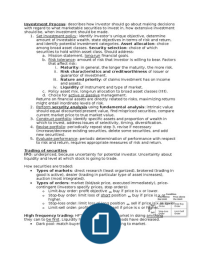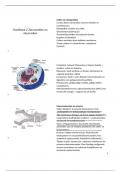with regard to what marketable securities to invest in, how extensive investment
should be, when investment should be made.
1. Set investment policy: identify investor’s unique objective, determine
amount of investable wealth, state objectives in terms of risk and return,
and identify potential investment categories. Asset allocation: choice
among broad asset classes. Security selection: choice of which
securities to hold within asset class. Should address:
a. Mission statement, long-run financial goals.
b. Risk tolerance: amount of risk that investor is willing to bear. Factors
that affect risk:
i. Maturity: in general, the longer the maturity, the more risk.
ii. Risk characteristics and creditworthiness of issuer or
guarantor of investment.
iii. Nature and priority: of claims investment has on income
and assets.
iv. Liquidity of instrument and type of market.
c. Policy asset mix, long-run allocation to broad asset classes (!!!).
d. Choice for active or passive management.
Returns on financial assets are directly related to risks, maximizing returns
might entail inordinate levels of risk.
2. Perform security analysis using fundamental analysis: intrinsic value
should equal discounted present value, find mispriced securities, compare
current market price to true market value.
3. Construct portfolio: identify specific assets and proportion of wealth in
which to invest, address issues of selectivity, timing, diversification.
4. Revise portfolio: periodically repeat step 3, revise if necessary
(increase/decrease existing securities, delete some securities, and add
new securities).
5. Evaluate performance: periodic determination of performance with respect
to risk and return, requires appropriate measures of risk and return.
Trading of securities
IPO: underpriced, because uncertainty for potential investor. Uncertainty about
liquidity and level at which stock is going to trade.
How securities are traded:
Types of markets: direct research (least organized), brokered (trading in
good is active), dealer (trading in particular type of asset increases),
auction (most integrated).
Types of orders: market (bid/ask price, executed immediately), price-
contingent (investors specify prices, stop orders):
o Limit-buy order: profit objective buy if price is x or lower.
o Stop-buy order: limit loss of short position buy if price is x or
higher.
o Stop-loss order: limit loss of long position sell if price is x or lower.
o Limit-sell order: profit objective sell if price is x or higher.
High frequency trading: HFT firms are gaming market in doing anything
they can to be first. Liquidity has increased and spreads have decreased.
Dark pool: match buyer and seller without going to market.
, Short sale: profit from decline in asset price, when you expect price of stock to
go down: sell stock that you don’t own buy back in future if price is down.
Profit short (negative investment in security) = initial price –(ending price
+ dividend)
Profit long (positive investment in security) = (ending price + dividend) –
initial price
Buying on margin: use only portion of proceeds for investment, borrow
remaining component to buy shares.
Margin: currently 50% borrow up to 50% of stock value (set by Fed).
Maintenance margin: minimum amount equity in trading can be before
additional funds must be put into account, if your collateral drops to
maintenance margin, you have to give extra collateral.
Margin call: notification from broker that additional funds are needed.
Percentage margin:
Why buying on margin? Create leverage to invest total return increases (rate
of return increases), more money to invest. Upside potential increase, but
downside risk as well.
Investment companies/mutual funds
Investment companies: collect funds from individual investors and invest
those in of securities or other assets, investors have claim in proportion to
amount invested, services:
Administration & record keeping;
Diversification & divisibility;
Professional management;
Reduced transaction costs.
Net Asset Value: to calculate claim in fund, basis for valuation of Investment
Companies shares (selling new shares, redeeming existing shares)
Market Value of Assets−Liabilities
¿
Shares Outstanding
Types of investment organizations:
Unit trusts: only accessible at a certain age (or other restrictions), mostly
rich people saving for their children;
Managed investment companies:
o Open-End (= mutual funds, SEC regulated): no restriction on
amount of shares it will issue (can issue/redeem at every moment),
not allowed to go short;
o Closed-End: publicly traded IC that raises fixed amount of capital
through IPO, shares not issued to meet demand of investor.
Other investment organizations:
o REITs: similar to closed-end fund, invest in real estate or loans
secured by real estate;
o Hedge funds: look for mispriced assets (almost not regulated, high
fees), allowed to go short.
Open-End versus Closed-End mutual funds:
Shares outstanding:
o Open-end: changes when new shares are sold or old shares are
redeemed.





